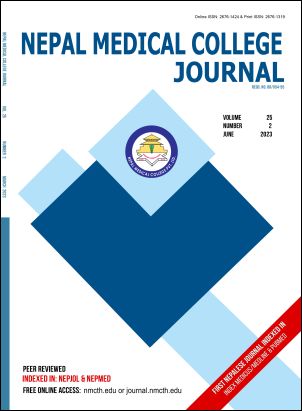Prevalence of incidental lumbosacral spondylolysis on multidetector computed tomography in Nepalese population
DOI:
https://doi.org/10.3126/nmcj.v25i2.56047Keywords:
Spondylolysis, spondylolisthesis, multidetector CT scanAbstract
Spondylolysis is aunilateral or bilateralanatomical defect of pars interarticularis of vertebral arch and commonly occurs at L5-S1 level (85-95%) and L4-5level (5-15%). It is one of the most common causes of lower back pain (LBP), is prevalent in approximately 6% of population and can progress to spondylolisthesiswhich in turn can cause radiculopathy. Although majority of patients may remain asymptomatic, symptomatic patients in early stages usually benefit from conservative treatment. Hence, early identification is very important and multidetector CT (MDCT) scan is the most sensitive technique to diagnose spondylolysis and spondylolisthesis. The prevalence and long-term prognosis of spondylolysis is still not known in the context of Nepal. This study aims to find out the prevalence of incidental lumbosacral spondylolysis on CT scan inNepalese population. Cross-sectional descriptive studydata was collected from 2629 CT abdomen and pelvis performed during four and half year’s period at Nepal Medical College and Teaching Hospital. Presence of spondylolysis was evaluated on multiplanar and volumetric images. Associated feature like spondylolisthesis was also noted. Data obtained was compiled and analyzed using Statistical Package of Social Services – 20 (SPSS-20). Out of total 2629 patients, 1135 were males (43.1%) and 1494 were females (56.9%). Youngest was 14 year and oldest was 102 year old. There was linear positive relation between the age of the patients and frequency of spondylolysis. Incidental lumbosacral spondylolysis was seen in 146 patients with overall prevalence of 5.5%. Out of which 71 were males with 6.2 % prevalence and 75 were females with 5.0 % prevalence.Females were nearly equally affected as males. Frequency of spondylolysis was more in below 60 year (57.5%) compared to above 60 year age group (42.5%). Commonest location was at L5-S1 level, seen in 134 patients (91.8%) followed by L4-L5 level in 8 patients (5.5 %) and both L4-L5 and L5-S1 levels in 4 patients (2.7 %). Spondylolisthesis was seen in 43 (29.5 %) out of 146 patients with spondylolysis, out of which 15 were males (34.9%) and 28 were females (65.1%). In presence of spondylolysis, females had more statistically significant prevalence of spondylolisthesis than males (p value<0.05). The overall prevalence of spondylolysis and at levels at which it occurs concur with that of established literatures. However, this study shows that females are only slightly less affected than males and is nearly equally prevalent in below 60 year age group unlike shown in previous studies.
Downloads
Downloads
Published
How to Cite
Issue
Section
License
Copyright (c) 2023 Nepal Medical College Journal

This work is licensed under a Creative Commons Attribution 4.0 International License.
This license enables reusers to distribute, remix, adapt, and build upon the material in any medium or format, so long as attribution is given to the creator. The license allows for commercial use.




